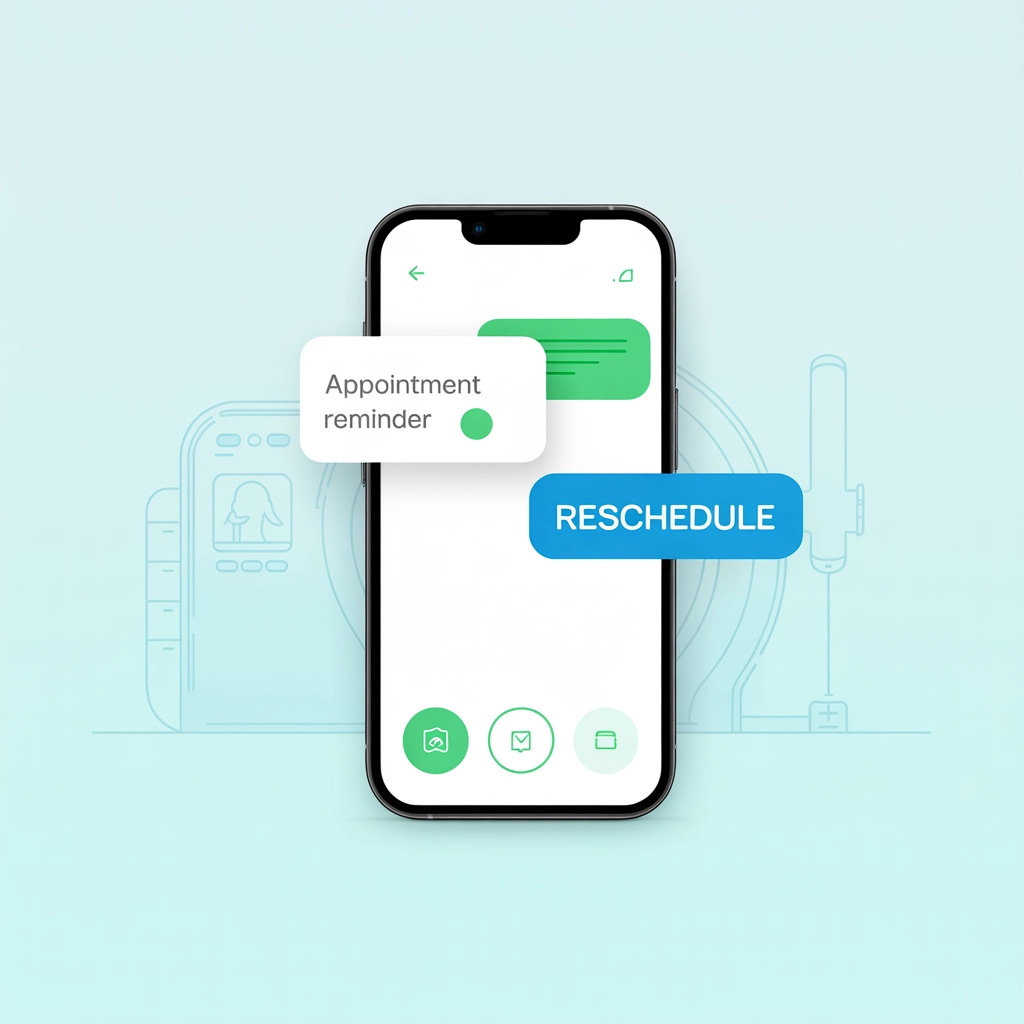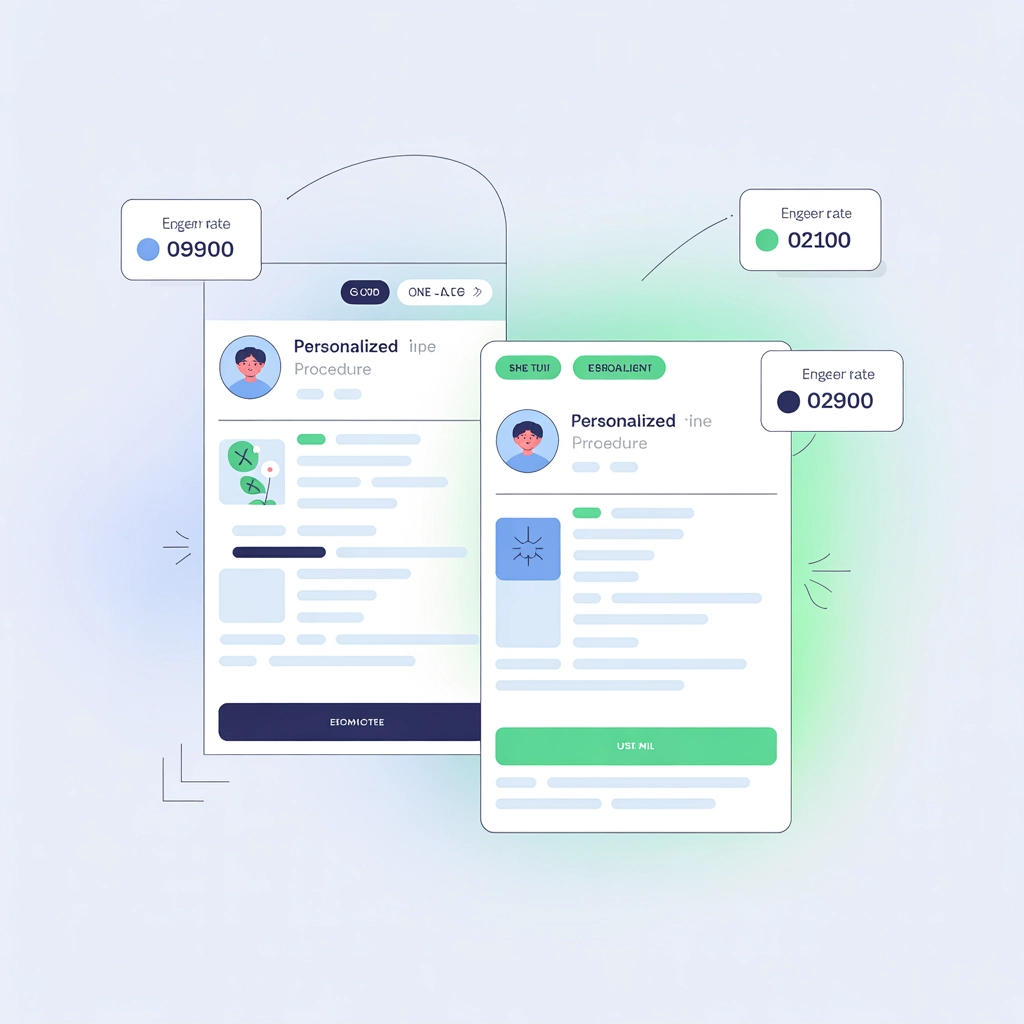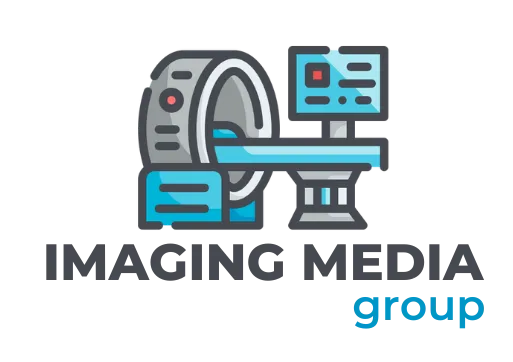
Patient Engagement 2.0. How to Use SMS & Email Campaigns to Reduce No-Shows
The Hidden Cost of No-Shows in Imaging Centers
For imaging centers, few challenges impact operational efficiency and revenue as significantly as appointment no-shows. When patients fail to arrive for scheduled MRIs, CT scans, ultrasounds, or other imaging procedures, the consequences extend far beyond a simple gap in the day's schedule.
The average no-show rate for imaging appointments ranges from 12% to 24%, with specialized procedures often experiencing even higher rates. Each missed appointment represents not only immediate lost revenue but also wasted staffing resources, underutilized equipment, and extended wait times for other patients who could have benefited from those slots.
"Every no-show costs an imaging center approximately $400-700 in direct revenue, but when you calculate the downstream impact on workflow efficiency and patient satisfaction, the true cost can be significantly higher," notes Dr. James Reynolds, Chief Medical Officer at Northside Imaging Associates.
The good news? Modern patient engagement strategies, particularly those leveraging digital communication tools, have demonstrated remarkable effectiveness in reducing these costly disruptions.
Understanding Patient Engagement 2.0
Healthcare has evolved beyond the traditional doctor-patient relationship model. Patient Engagement 2.0 represents the next generation of healthcare communication strategy—one that recognizes patients as active participants in their care journey rather than passive recipients of services.
Where Patient Engagement 1.0 focused primarily on basic appointment reminders and portal access, version 2.0 embraces comprehensive digital communication ecosystems that facilitate ongoing, personalized interactions across multiple touchpoints.
The foundation of this approach includes:
Multi-channel communication that respects patient preferences
Bi-directional engagement allowing patients to respond and interact
Personalized messaging that addresses individual needs and barriers
Data-driven strategies that continuously optimize based on patient behavior
Seamless integration with existing workflows and systems
For imaging centers specifically, implementing these principles through SMS and email campaigns offers a powerful solution to the persistent challenge of appointment no-shows.
The Psychology Behind No-Shows: Understanding Why Patients Miss Appointments
Before diving into technical solutions, it's crucial to understand the underlying reasons patients miss imaging appointments. Research consistently identifies several key factors:
Fear and anxiety about imaging procedures or potential results
Scheduling conflicts that arise after booking
Transportation challenges or logistical barriers
Forgetfulness or competing priorities
Financial concerns about costs or insurance coverage
Lack of perceived importance of the procedure
Communication barriers (language, technology access, etc.)
Effective SMS and email campaigns address these root causes rather than merely reminding patients of dates and times. When designing your communication strategy, each message should work to overcome these specific barriers.
SMS Strategies That Drive Appointment Adherence
Text messaging has emerged as one of the most effective channels for reducing no-shows, with studies showing that SMS reminders can decrease missed appointments by 25-35% when properly implemented. Here are the most impactful SMS strategies for imaging centers:
1. Strategic Timing of Reminders
The timing of your SMS reminders significantly impacts their effectiveness:
Initial confirmation immediately after scheduling
Pre-appointment preparation reminder 5-7 days before (especially important for procedures requiring preparation)
48-hour reminder allowing adequate time for rescheduling if needed
24-hour reminder with specific preparation instructions
Same-day reminder a few hours before the appointment
This cadence provides multiple touchpoints without overwhelming patients, addressing both preparation needs and memory-related barriers.
2. Interactive Two-Way Messaging
One-way reminders are beneficial; two-way conversations are even more effective. Implement SMS systems that allow patients to:
Confirm attendance with a simple "Y" or "1"
Request rescheduling by replying "R" or "2"
Ask questions by replying "Q" or "3"
When patients can easily respond and receive automated or staff assistance, they're more likely to communicate challenges rather than simply not showing up.
3. Embedded Rescheduling Links
Remove friction from the rescheduling process by including direct links within your SMS messages:
This approach acknowledges scheduling conflicts (a primary no-show reason) and provides an immediate solution.

4. Procedure-Specific Preparation Instructions
Patients often miss appointments when they're uncertain about preparation requirements. Send procedure-specific instructions via SMS:
These targeted instructions increase confidence and readiness, particularly for complex imaging procedures.
5. Transportation Solutions
For patients facing transportation barriers, consider implementing SMS campaigns that include:
Links to rideshare services with potential discount codes
Information about public transportation routes
Parking details and validation information
Options for patient transportation services if available
By addressing logistical barriers directly, you remove a significant obstacle to appointment attendance.
Email Campaign Strategies for Comprehensive Engagement
While SMS excels at timely reminders, email provides a complementary channel for more detailed communication. Here's how to maximize email effectiveness:
1. Educational Content Delivery
Use email to address anxiety and uncertainty by providing educational content about upcoming procedures:
Detailed explanations of what to expect
Links to videos showing the imaging environment
FAQs addressing common concerns
Information about the importance of the specific imaging procedure
Preparation checklists in downloadable formats
"Educational content delivered prior to appointments not only reduces anxiety but also reinforces the importance of the procedure," explains Sarah Johnson, Patient Experience Director at Conversation Assist. "When patients understand both the 'how' and 'why' of their imaging appointment, they're significantly more likely to prioritize attendance."
2. Branded, Mobile-Responsive Templates
Your email communications should reinforce your imaging center's professional identity while functioning perfectly on mobile devices:
Clean, consistent branding with your center's logo and colors
Large, touch-friendly buttons for confirmations or rescheduling
Critical information (date, time, location) highlighted at the top
Alternative text contact methods for patients with limited email access
Accessibility features for patients with disabilities
3. Personalized Subject Lines and Content
Generic emails generate lower open rates. Personalize your messages with:
The patient's name in the subject line
Reference to the specific procedure they're scheduled for
The referring physician's name (when appropriate)
Personalized maps or directions from their general location
Previous visit information if they've been to your facility before
Research shows personalized emails generate 29% higher open rates and 41% higher click rates in healthcare communications.

4. Digital Intake Form Integration
Streamline the appointment process by including digital intake forms in your email campaigns:
Pre-registration forms that can be completed before arrival
Insurance verification links
Medical history updates
Required consent documents
This approach not only reduces no-shows but also improves operational efficiency when patients do arrive.
5. Post-Missed Appointment Recovery Campaigns
For patients who do miss appointments, implement automated recovery emails:
Non-judgmental acknowledgment of the missed appointment
Easy rescheduling options with multiple available slots
Emphasis on the importance of the procedure for their health
Potential alternatives (different locations, telehealth pre-screenings if applicable)
These recovery campaigns can recapture 15-20% of no-shows when properly implemented.
Integration and Automation: Creating a Cohesive Communication Ecosystem
The most effective patient engagement strategies integrate SMS and email within a comprehensive communication ecosystem. Here's how to build this infrastructure:
1. CRM Integration for Personalized Communication
Connecting your patient engagement tools with your customer relationship management (CRM) system enables truly personalized communication. Solutions like Sales Pilot CRM can help imaging centers:
Track patient communication preferences
Monitor engagement patterns across channels
Identify high-risk patients for additional outreach
Customize messaging based on patient history
Automate workflows while maintaining a personal touch
2. Creating Logical Communication Workflows
Develop communication workflows that consider patient behavior and preferences:
Primary channel identification: Determine whether a patient prefers SMS or email as their primary contact method
Escalation protocols: If no response is received via the preferred channel, automatically escalate to secondary channels
Feedback integration: Adjust future communications based on which messages generate the highest response rates
Staff alert triggers: Notify staff when direct intervention may be needed for high-risk or high-value appointments
3. A/B Testing for Continuous Optimization
No patient engagement strategy should remain static. Implement ongoing A/B testing to determine:
Optimal message timing for your specific patient population
Most effective message wording and tone
Ideal reminder frequency
Most compelling call-to-action phrases
Best-performing subject lines for emails
"The imaging centers seeing the greatest reduction in no-shows are those continuously refining their communication strategy based on patient response data," notes Michael Chen, Analytics Director at Mixed Media Ventures. "Small tweaks in messaging can lead to significant improvements in appointment adherence."
4. Respecting Patient Preferences and Privacy
Effective engagement requires respecting boundaries:
Obtain proper consent for all communication channels
Provide clear opt-out instructions in every message
Ensure all communications are HIPAA-compliant
Allow patients to update communication preferences easily
Train staff on proper information handling protocols
Measuring Success: Key Metrics for Patient Engagement Campaigns
To evaluate the effectiveness of your SMS and email campaigns, monitor these critical metrics:
1. No-Show Rate Tracking
The most direct measure of success is your no-show rate, which should be tracked:
Overall for the facility
By procedure type
By day of week/time of day
By patient demographics
By referring physician
2. Communication Engagement Metrics
Monitor how patients interact with your messages:
Email open rates (industry benchmark: 20-25%)
SMS read receipts (when available)
Click-through rates on links
Response rates to interactive elements
Opt-out/unsubscribe rates
3. Operational Efficiency Improvements
Track secondary benefits:
Reduction in idle equipment time
Staff productivity improvements
Decrease in overtime costs related to schedule disruptions
Improved patient throughput

4. Return on Investment Calculation
Calculate the ROI of your patient engagement system:
Cost of implementation and ongoing operation
Revenue recaptured from reduced no-shows
Efficiency savings from streamlined workflows
Staff time saved on manual reminder calls
Most imaging centers implementing comprehensive patient engagement systems report ROI ranging from 5:1 to 10:1.
Implementation Challenges and Solutions
While the benefits are clear, implementing effective patient engagement systems does present challenges:
1. Technical Integration Issues
Challenge: Many imaging centers operate with legacy systems that don't easily connect with modern communication platforms.
Solution:
Prioritize engagement solutions with robust API capabilities
Consider middleware solutions that can bridge legacy and modern systems
Implement in phases, starting with standalone campaigns before full integration
Partner with vendors experienced in healthcare system integration
2. Staff Adoption and Workflow Adaptation
Challenge: New communication systems require staff buy-in and adjustments to existing workflows.
Solution:
Involve staff in the selection and implementation process
Provide comprehensive training with real-world scenarios
Start with pilot programs in specific departments
Demonstrate time-saving benefits to encourage adoption
3. Patient Technology Barriers
Challenge: Some patient populations have limited access to or comfort with digital communication.
Solution:
Maintain alternative communication channels for patients with technology limitations
Provide clear instructions for accessing and responding to digital communications
Implement age-appropriate messaging strategies
Offer family member options for managing communications when appropriate
4. Compliance and Security Concerns
Challenge: Healthcare communications must adhere strictly to privacy regulations.
Solution:
Select vendors with strong healthcare compliance track records
Implement regular security audits
Develop clear policies for handling protected health information
Train all staff on proper communication protocols
Putting It All Together: A Strategic Implementation Roadmap
For imaging centers ready to implement or enhance their patient engagement strategies, follow this phased approach:
Phase 1: Assessment and Planning (1-2 months)
Audit current no-show rates and identify patterns
Survey patients about communication preferences
Evaluate technology options and select appropriate solutions
Develop specific messaging templates and workflows
Phase 2: Initial Implementation (2-3 months)
Deploy basic SMS reminder system
Implement fundamental email campaigns
Train staff on new processes
Establish baseline metrics for evaluation
Phase 3: Refinement and Expansion (3-6 months)
Add interactive elements to communications
Implement A/B testing protocols
Integrate with existing systems (scheduling, EMR)
Expand to include educational content
Phase 4: Advanced Integration (6+ months)
Develop predictive analytics to identify high-risk patients
Implement personalized communication journeys
Integrate patient feedback mechanisms
Establish continuous improvement protocols
Conclusion: The Future of Patient Engagement for Imaging Centers
As healthcare continues to evolve, the imaging centers that thrive will be those that embrace comprehensive patient engagement strategies. SMS and email campaigns represent the foundation of these efforts, offering measurable reductions in no-shows while simultaneously improving patient satisfaction and operational efficiency.
The most successful implementations recognize that technology alone isn't enough—effective patient engagement combines the right tools with thoughtful messaging, strategic timing, and continuous optimization. When implemented correctly, these systems not only reduce no-shows but also transform the entire patient experience.
By addressing the specific barriers patients face—from fear and forgetfulness to transportation challenges and preparation confusion—modern engagement systems create pathways to successful appointments that benefit both patients and providers.
Next Steps for Your Imaging Center
Ready to reduce no-shows and enhance patient engagement at your imaging center? Consider these action items:
Conduct a No-Show Audit: Analyze your current no-show patterns to identify your most significant opportunities for improvement.
Evaluate Your Current Communication Strategy: Does it address the core reasons patients miss appointments at your facility?
Explore Technology Solutions: Schedule demonstrations with patient engagement vendors experienced in imaging center implementations.
Develop a Phased Implementation Plan: Create a roadmap for gradually enhancing your patient communication ecosystem.
For personalized guidance on implementing effective patient engagement strategies for your imaging center, contact the healthcare marketing experts at Imaging Media Group. Our team specializes in helping imaging centers develop effective communication strategies that reduce no-shows, enhance patient experience, and optimize operational efficiency.
Still have questions? Want to see how we can help you achieve success? Reach out.
Use the form to the right to reach out to us and speak with a representative, and learn how you can grow your Imaging Center.
Let's Chat
Contact Us
© 2025 Imaging Media Group - All Rights Reserved
Imaging Media Group and SalesPilot CRM are divisions of Mixed Media Ventures

